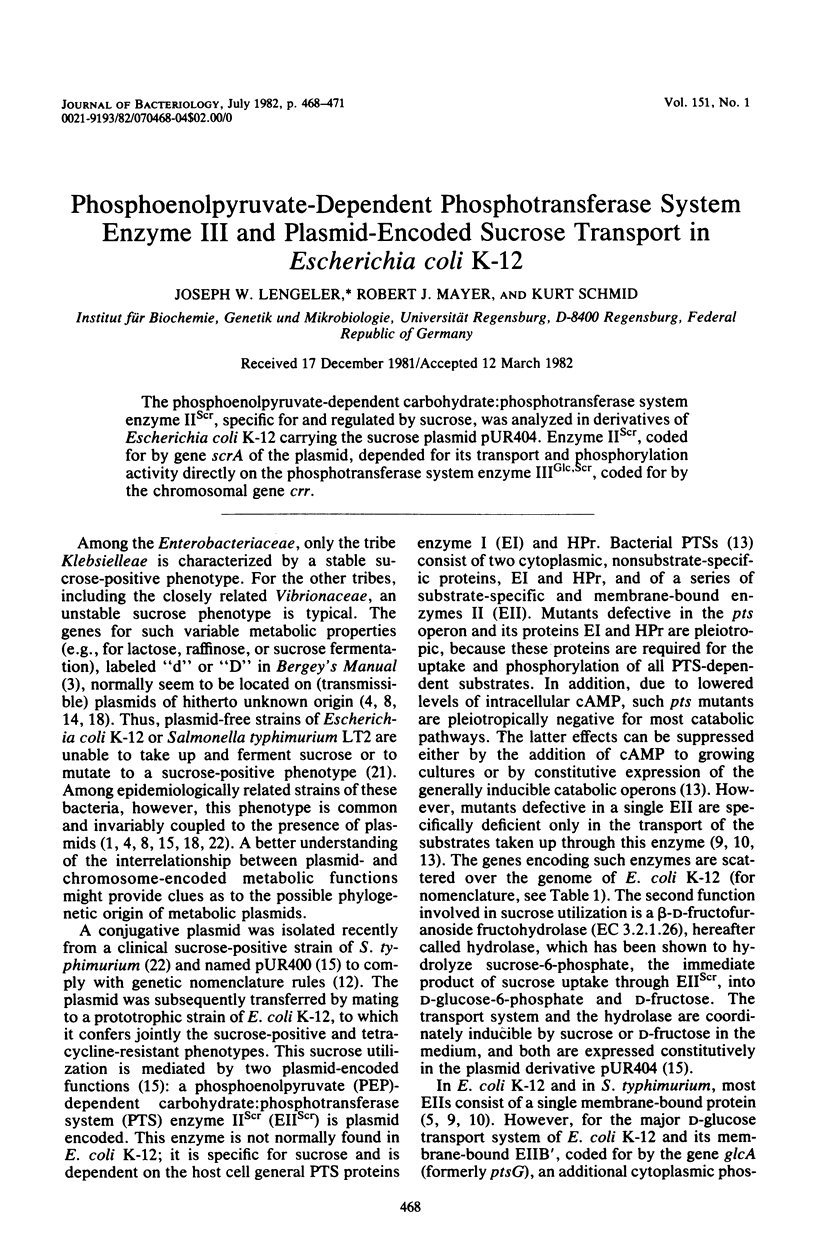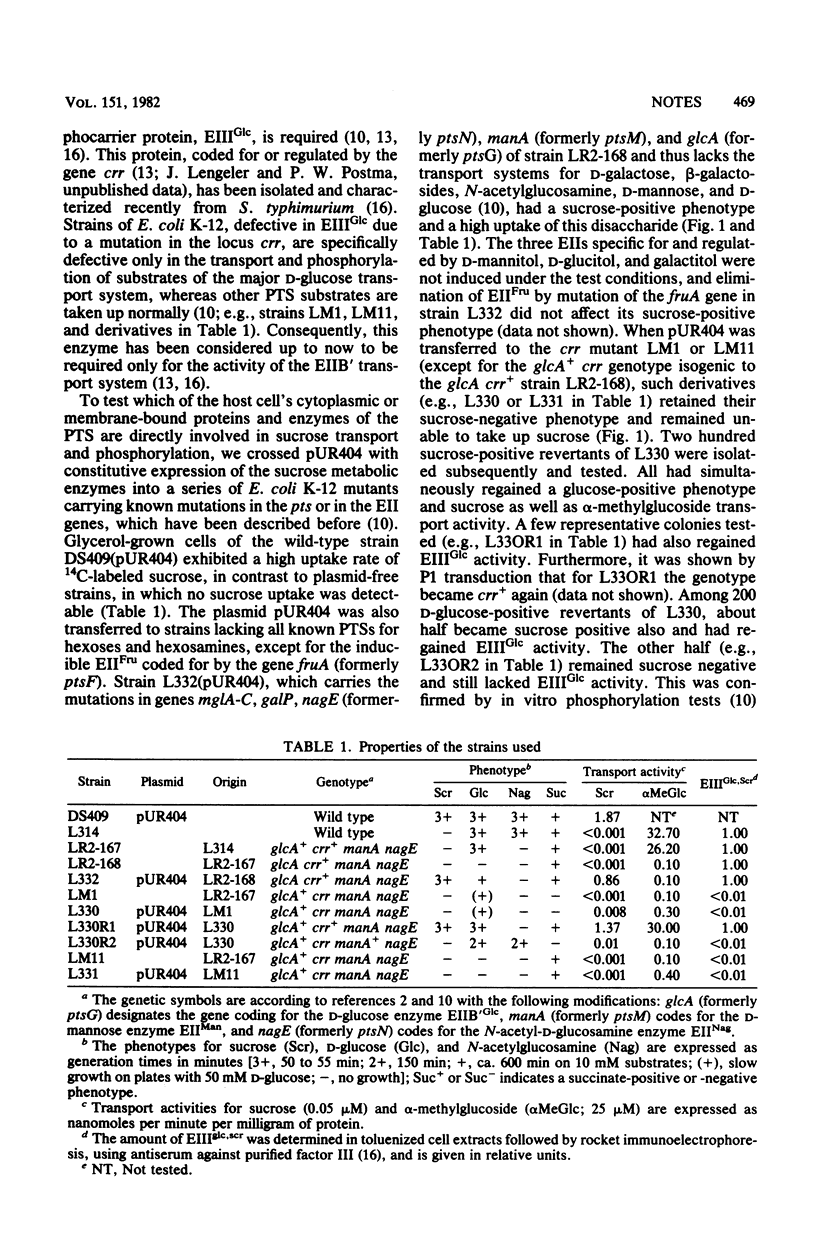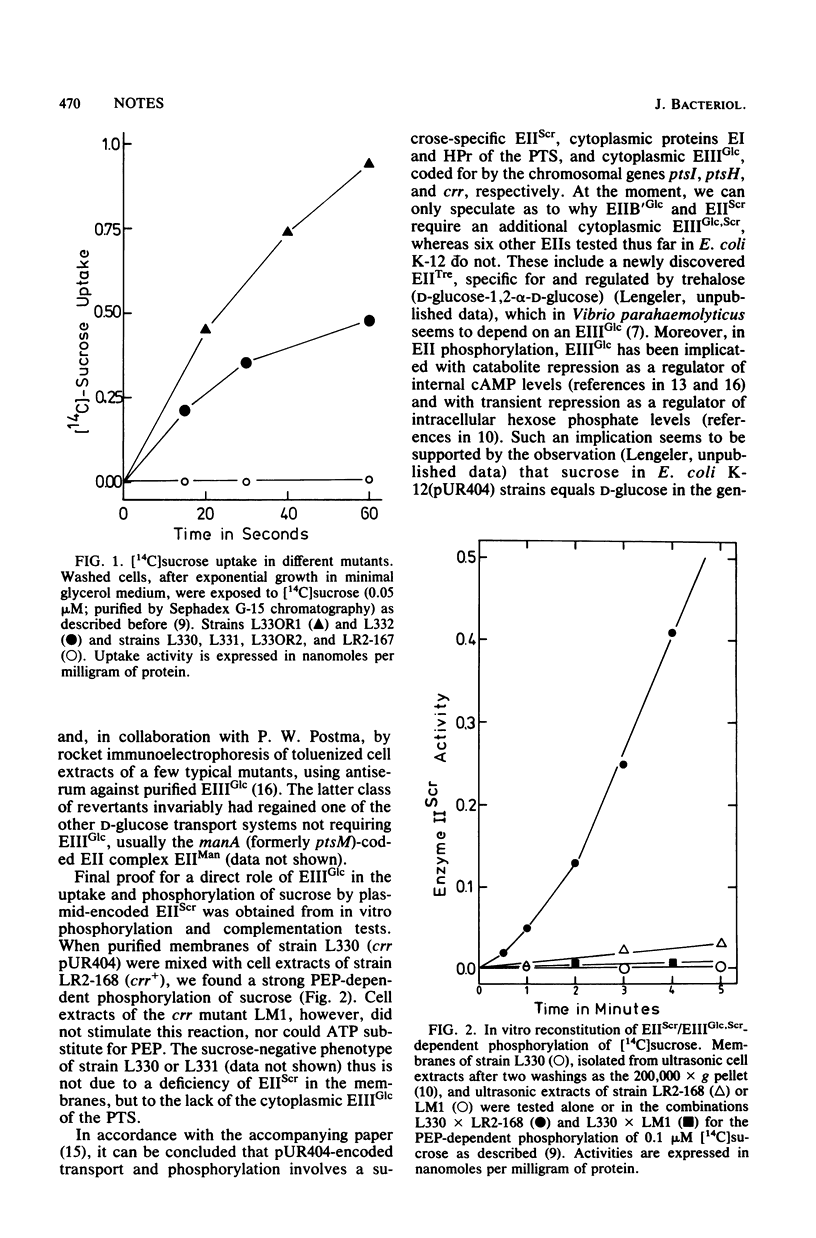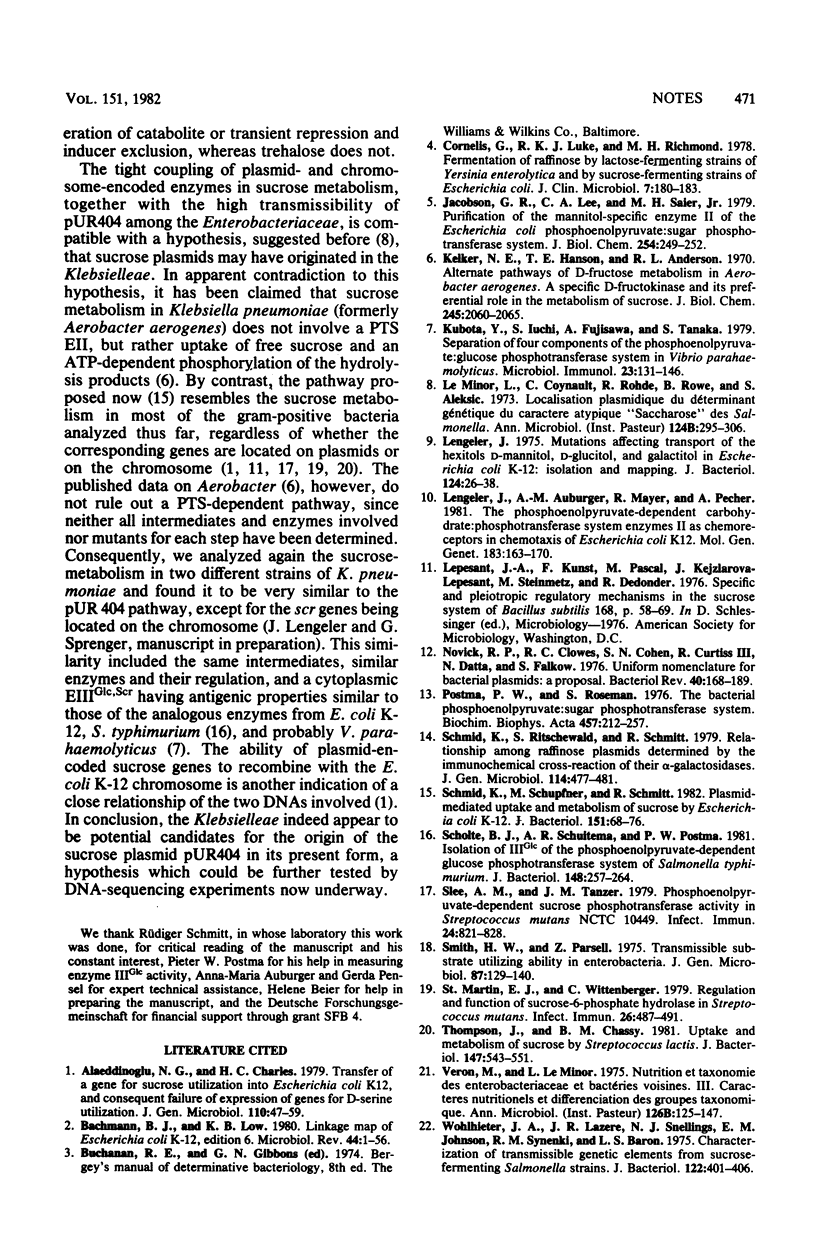Abstract
The phosphoenolpyruvate-dependent carbohydrate:phosphotransferase system enzyme IISCR, specific for and regulated by sucrose, was analyzed in derivatives of Escherichia coli K-12 carrying the sucrose plasmid pUR404. Enzyme IIScr, coded for by gene scrA of the plasmid, depended for its transport and phosphorylation activity directly on the phosphotransferase system enzyme IIIGlc, Scr, coded for by the chromosomal gene crr.
Full text
PDF



Selected References
These references are in PubMed. This may not be the complete list of references from this article.
- Alaeddinoglu N. G., Charles H. P. Transfer of a gene for sucrose utilization into Escherichia coli K12, and consequent failure of expression of genes for D-serine utilization. J Gen Microbiol. 1979 Jan;110(1):47–59. doi: 10.1099/00221287-110-1-47. [DOI] [PubMed] [Google Scholar]
- Bachmann B. J., Low K. B. Linkage map of Escherichia coli K-12, edition 6. Microbiol Rev. 1980 Mar;44(1):1–56. doi: 10.1128/mr.44.1.1-56.1980. [DOI] [PMC free article] [PubMed] [Google Scholar]
- Cornelis G., Luke R. K., Richmond M. H. Fermentation of raffinose by lactose-fermenting strains of Yersinia enterocolitica and by sucrose-fermenting strains of Escherichia coli. J Clin Microbiol. 1978 Feb;7(2):180–183. doi: 10.1128/jcm.7.2.180-183.1978. [DOI] [PMC free article] [PubMed] [Google Scholar]
- Jacobson G. R., Lee C. A., Saier M. H., Jr Purification of the mannitol-specific enzyme II of the Escherichia coli phosphoenolpyruvate:sugar phosphotransferase system. J Biol Chem. 1979 Jan 25;254(2):249–252. [PubMed] [Google Scholar]
- Kelker N. E., Hanson T. E., Anderson R. L. Alternate pathways of D-fructose metabolism in Aerobacter aerogenes. A specific D-fructokinase and its preferential role in the metabolism of sucrose. J Biol Chem. 1970 Apr 25;245(8):2060–2065. [PubMed] [Google Scholar]
- Kubota Y., Iuchi S., Fujisawa A., Tanaka S. Separation of four components of the phosphoenolpyruvate: glucose phosphotransferase system in Vibrio parahaemolyticus. Microbiol Immunol. 1979;23(3):131–146. doi: 10.1111/j.1348-0421.1979.tb00450.x. [DOI] [PubMed] [Google Scholar]
- Le Minor L., Coynault C., Rohde R., Rowe B., Aleksic S. Localisation plasmidique du déterminant génétique du caractète atypique "saccharose plus" des Salmonella. Ann Microbiol (Paris) 1973 Oct;124(3):295–306. [PubMed] [Google Scholar]
- Lengeler J., Auburger A. M., Mayer R., Pecher A. The phosphoenolpyruvate-dependent carbohydrate: phosphotransferase system enzymes II as chemoreceptors in chemotaxis of Escherichia coli K 12. Mol Gen Genet. 1981;183(1):163–170. doi: 10.1007/BF00270156. [DOI] [PubMed] [Google Scholar]
- Lengeler J. Mutations affecting transport of the hexitols D-mannitol, D-glucitol, and galactitol in Escherichia coli K-12: isolation and mapping. J Bacteriol. 1975 Oct;124(1):26–38. doi: 10.1128/jb.124.1.26-38.1975. [DOI] [PMC free article] [PubMed] [Google Scholar]
- Novick R. P., Clowes R. C., Cohen S. N., Curtiss R., 3rd, Datta N., Falkow S. Uniform nomenclature for bacterial plasmids: a proposal. Bacteriol Rev. 1976 Mar;40(1):168–189. doi: 10.1128/br.40.1.168-189.1976. [DOI] [PMC free article] [PubMed] [Google Scholar]
- Schmid K., Ritschewald S., Schmitt R. Relationships among raffinose plasmids determined by the immunochemical cross-reaction of their alpha-galactosidases. J Gen Microbiol. 1979 Oct;114(2):477–481. doi: 10.1099/00221287-114-2-477. [DOI] [PubMed] [Google Scholar]
- Schmid K., Schupfner M., Schmitt R. Plasmid-mediated uptake and metabolism of sucrose by Escherichia coli K-12. J Bacteriol. 1982 Jul;151(1):68–76. doi: 10.1128/jb.151.1.68-76.1982. [DOI] [PMC free article] [PubMed] [Google Scholar]
- Scholte B. J., Schuitema A. R., Postma P. W. Isolation of IIIGlc of the phosphoenolpyruvate-dependent glucose phosphotransferase system of Salmonella typhimurium. J Bacteriol. 1981 Oct;148(1):257–264. doi: 10.1128/jb.148.1.257-264.1981. [DOI] [PMC free article] [PubMed] [Google Scholar]
- Slee A. M., Tanzer J. M. Phosphoenolpyruvate-dependent sucrose phosphotransferase activity in Streptococcus mutans NCTC 10449. Infect Immun. 1979 Jun;24(3):821–828. doi: 10.1128/iai.24.3.821-828.1979. [DOI] [PMC free article] [PubMed] [Google Scholar]
- Smith H. W., Parsell Z. Transmissible substrate-utilizing ability in enterobacteria. J Gen Microbiol. 1975 Mar;87(1):129–140. doi: 10.1099/00221287-87-1-129. [DOI] [PubMed] [Google Scholar]
- St Martin E. J., Wittenberger C. L. Regulation and function of sucrose 6-phosphate hydrolase in Streptococcus mutans. Infect Immun. 1979 Nov;26(2):487–491. doi: 10.1128/iai.26.2.487-491.1979. [DOI] [PMC free article] [PubMed] [Google Scholar]
- Thompson J., Chassy B. M. Uptake and metabolism of sucrose by Streptococcus lactis. J Bacteriol. 1981 Aug;147(2):543–551. doi: 10.1128/jb.147.2.543-551.1981. [DOI] [PMC free article] [PubMed] [Google Scholar]
- Véron M., Le Minor L. Nutrition et taxonomie des enterobacteriaceae et bactéries voisines. III. Caractères nutritionnels et differenciation des groupes taxonomiques. Ann Microbiol (Paris) 1975 Sep;126(2):125–147. [PubMed] [Google Scholar]
- Wohlhieter J. A., Lazere J. R., Snellings N. J., Johnson E. M., Synenki R. M., Baron L. S. Characterization of transmissible genetic elements from sucrose-fermenting Salmonella strains. J Bacteriol. 1975 May;122(2):401–406. doi: 10.1128/jb.122.2.401-406.1975. [DOI] [PMC free article] [PubMed] [Google Scholar]


